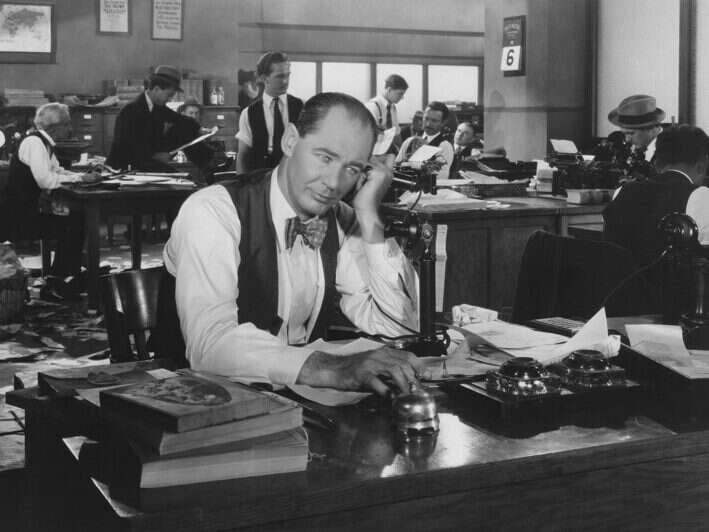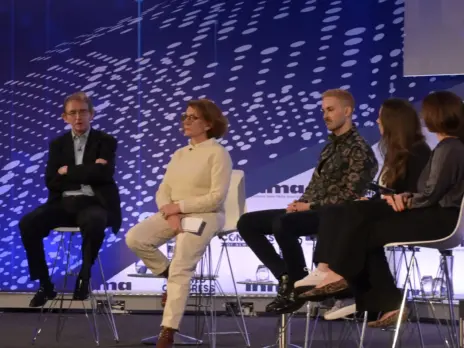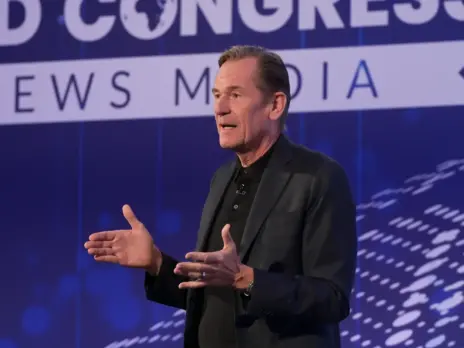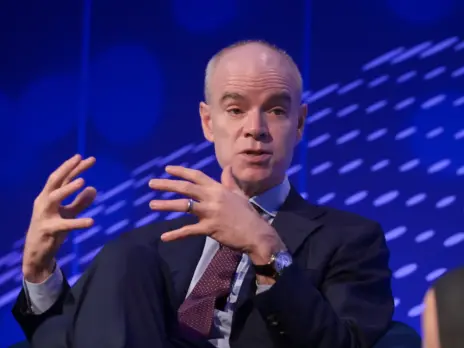
In the 1990s, men working for the BBC would be expected to come to work in suit and tie. “Anyone detracting from that would be asked by an editor: ‘What would happen if the Prime Minister turned up?’” recalls one veteran of the corporation. “It was bonkers, of course, to dress up only to sit in a studio all day reading the news. These days casual is welcomed and encouraged.”
The BBC is not alone, especially in the aftermath of the Covid-19 pandemic, which caused many journalists to work from home and adjust their wardrobes.
Before 2020, suits and business attire were the norm for men and women across many newsrooms. In 2022, few British newsrooms compel their staff to dress formally – and many journalists now view ties and high heels as relics of the past in the workplace.
To investigate newsroom fashion trends and dress codes, Press Gazette conducted an informal survey of journalists across Fleet Street, the broadcast sector, magazines, digital publishers and the regional press.
We found that, while there does appear to have been a trend towards dressing down in recent years, traditionalists can take heart from the fact that there do remain a few final bastions of formalwear.
Our research suggests that British newsroom dress codes can be roughly broken down into four categories: the Old Guard, the Geography Teachers, the Gen Z Fashionable Types and the WFHers.
Dress codes can vary within newsrooms – digital staff on Old Guard newspapers often tend to be Gen Z Fashionable Types. And many journalists themselves shift between categories – even Huw Edwards, the king of the Old Guard, can be spotted around the BBC offices in M&S knitwear (very much the hallmark of a Geography Teacher) in the hours before a broadcast.
Regardless, we’ve tried our best to categorise newsrooms and journalists as best we can in Press Gazette’s first (and likely final) newsroom fashion guide.
The Old Guard
Dress code: Suits, formal dresses, businesswear – ties optional. Advocates: Daily Mail, the Lobby, The Sun, Ian Hislop, Huw Edwards, on-screen broadcasters.

As the BBC source above notes, suits and formal clothing would have been the norm across most British newsrooms not too long ago. And there do remain some formal strongholds – notably, the Lobby, the Daily Mail and television news screens.
BBC presenter Huw Edwards admitted, though, that even he can occasionally be spotted without a suit and tie.
“I usually wear my less formal (!) attire until about an hour before I’m due to be on air,” he emailed. “So this would be some of my finest M&S knitwear and jeans. But the challenge is where to get changed as I have no proper changing room. So I hide behind the cupboards in the corner of the newsroom. I am a byword for discretion.”
Adam Boulton, a veteran on-screen political journalist, said: “For men the big issue is the tie. I’ve always worn one because that was the dress code at Westminster and because most of the men I interviewed were likely to be wearing one too. I also think that reporting and interviewing should be formal rather than relaxed. You are not your subjects’ friend but on TV you are coming right in to their home and respect should be shown.
“Much though I like ties – I’ve got over a thousand – I have to accept that their day is nearly done. David Cameron started the rot in his ‘call me Dave’ phase.”
Sophia Sleigh, deputy political editor at Huff Post UK, said that for young female journalists, formal dress can be essential. “If you’re out meeting people: smart smart smart,” she tweeted. “Jackets, polo necks, shirts, dresses, skirts, smart trousers etc. If you look like a young[ish] woman you must show you mean business. Too many too quick to patronise/ underestimate you (although latter can come in handy!)”
One tabloid political correspondent noted that many men in the Lobby still wear ties. He said that newspaper journalists “probably hold up the best sartorial standards”.
But, he added, standards have slipped since the pandemic. “Now it’s not unusual to see shorts and jeans on a Thursday or a Friday,” the source fumed. “You still need a jacket to get into the Commons chamber, but you can get away without a tie – which is frankly a disgrace.”
On Twitter, veteran political journalist Paul Waugh, chief political commentator for the i and a former chairman of the Lobby, confirmed that the “tie stipulation stopped a few years back”.
Hugo Gye, the i’s political editor, said: “I’ve never worn anything but a suit and tie to work, though I sometimes ditch the tie if working on a Sunday, or if working from home.”
Harry Cole, political editor of The Sun, recommends from experience that a Lobby journalist should “always be prepared to interview the PM at a moment’s notice”.
Away from Westminster, there remain a few newspaper offices that largely retain formal standards, most notably the Daily Mail.
One senior male journalist said that “not wearing a suit is frowned upon by middle and upper management”. He said the average outfit for a man would include suit trousers, a dark tie and a blue, white or pink shirt. For women, smart dresses are the norm, he added. “I don’t think it’s changed since the 1990s or 1980s.”
Another Mail man noted that the dress code has subtly changed with editors. Under Paul Dacre, they said, “the Mail was tie and black shoes” – rumour has it that Mail women were once, long ago, discouraged from wearing trousers in the newsroom. Standards were apparently relaxed under Geordie Greig in 2018, when staff felt comfortable removing ties and occasionally untucking shirts. Under the current editor, Ted Verity, “the newsdesk wear a tie, but reporters don’t”.
Trainees at the Mail are apparently told to “always carry clothes you could wear to a reception at Buckingham Palace and on a council estate – so always keep casual clothes in the back of your car”.
A female Sun journalist said of her newsroom: “Lots of women are in HIGH heels and are generally quite fashionably dressed.” She added that many men around The Sun office wear suits and ties – although there are some exceptions (see Gen Z Fashionable Types section below).
In most other newsrooms, this level of formalwear is confined mainly to individuals. One Evening Standard journalist said: “The old guard (what few left of them there are now – about three blokes) dress in a suit/jacket and tie.”
A Mirror insider said: “We’d pretty much given up ties before the pandemic – but there are still a couple of die hards in senior positions on the paper who are also suited and booted.”
A Sunday Times journalist said that deputy editor Ben Taylor, who is tipped to replace editor Emma Tucker if she leaves for The Wall Street Journal, is one of few in his newsroom to wear a suit.
Adam Macqueen of Private Eye said his editor, Ian Hislop, has only once been spotted without a suit. “He once had to wear jeans for a day when he did the “I’ve Never Seen Star Wars” programme on Radio 4,” Macqueen said. “Everyone politely assumed he was finally having his mid-life crisis.”
2. The Geography Teachers
Dress code: Smart casual, chinos, trainers, desert boots, jumpers. Advocates: The Guardian, FT, broadsheets, Press Gazette.

On the surface, given their target readership, one might expect the traditional broadsheets of the British media to enforce formalwear policies. Our research suggests this is not the case.
“The broadsheets seem to think it’s acceptable to dress like geography teachers these days,” rants one smartly-dressed tabloid section editor.
A senior FT journalist confessed: “It is much scruffier than it used to be! Default for men used to be jacket and shirt (no tie). But now you get a lot more people in casual clothes, especially Monday and Friday.”
A Sunday Times staffer said that suits are now a rarity on his title – with the exception of the business desk and deputy editor Ben Taylor. “The Times tends to be more formal than us,” added the Sunday Times journalist. (The Times and Sunday Times now occupy the same floor in the News Building.) “Most on our part of the floor are pretty casual.”
A Telegraph source said there are now “fewer suits” in his newsroom and “plenty of trainers”.
A journalist at the digital-only Independent said that most of her colleagues dress “sensibly, whether at the office or on Zoom/Teams.
“There are interesting exceptions,” she added. “Bright pink dresses, other instances of what might be referred to as fashion. Some (esp middle/top managers or old-guard journalists) still go for the suit, but it’s usually sans jacket, no tie, etc. The rest of us are mainly in cords and jumpers (men), and ordinary dress/skirt/trousers (women).”
A Guardian staffer said that, for him, “it is pretty uniformly a collared shirt with chinos, and usually a jumper. A blazer is definitely on the smarter end of things, and a suit will definitely draw questions from colleagues on most desks.
“For women it is much the same, albeit with more dresses going on. Suits are an even rarer sight. There is also a lot of variation between desks: jeans, trainers and T-shirt is an acceptable outfit for most, but the Lobby will always wear suits for Parliament. The only universal no-gos seem to be shorts and bare shoulders – when not working from home at least.”
Dan Taylor, a journalist at Tech.EU, tweeted: “Personally, I’m oft found in chinos, a jumper or smart hoodie paired with the occasional gillet and almost always a shemagh.”
Alex Turner, joint managing director of Thebusinessdesk.com, said that in his experience “smart-casual is increasingly shifting to comfortable-casual. Typically smarter for in-person although I almost never wear a tie now, even with lawyers, accountants and politicians.”
3. The Gen Z Fashionable Types
Dress code: Stylish, dungarees, Converse, Dr Martens, noisy trousers. Advocates: Online tabloids (and increasingly some print tabloids), off-screen broadcasters, Gen Zers (Note: not all advocates are members of Gen Z).

In the not-too-distant past, all tabloid journalists were expected to show up for work in suits.
Guardian columnist Marina Hyde recalled how, when she worked at The Sun as a celebrity reporter in the 1990s, “people always wore suits and ties – even the showbiz desk”. Some, but not all, women wore suits, while others were expected to turn up in “business dress”, Hyde said.
A current Sun showbiz journalist said that nowadays jeans, T-shirts and trainers are acceptable. “I used to wear a suit every day of the week, usually a tie, definitely smart trousers and shoes,” he said.
“These days I look more like a student! I mean, within reason – still needs to be presentable, of course, but often a T-shirt and jeans, trainers are totally acceptable these days. The suit only ever comes back out for a formal meeting or event.”
Before the pandemic, The Sun source added, there was a notable divide in dress between the digital team and the newspaper team. This has now broken down somewhat.
“I used to laugh about it looking like a sixth form common room on digital, now I’m exactly the same,” he said. “It doesn’t have any impact on productivity, and anything that encourages people to come to the office is good by me!”
A senior Mirror source told a similar tale. “Generally you can spot the difference between a principally paper reporter and online but it’s getting more blurred, and online are still smart.” An online staff member of the Mirror said there are “lots of open white shirts and occasionally suit jackets” in his office.
It’s not just the tabloids. One Telegraph staffer noted that there is a rise in Dr Martens footwear in his newsroom.
Jess Staufenberg, an education journalist, said: “My only rule was no blue jeans – black jeans or dark trousers. I’d not wear a strappy top as a usual rule, unless very, very warm on press day in summer and not meeting anyone external. The exception would be meeting ministers, where I’d concede to a blouse/shirt! No heels ever.”
New Statesman journalist Samir Jeraj said: “I’ve been complimented on both my multicoloured jumpsuit and red dungarees.”
Joe Ali, a journalist at Wales Online, tweeted that he wears high-top Converse shoes, T-shirts and “cargo pants. I also have tram lines in my hair.”
For older (perhaps less fashion-confident) newsroom staff, this relatively new form of dress can be mystifying and intimidating.
One longstanding BBC journalist recalled greeting a foreign dignitary with a dressed-down colleague. “The entire way to the studio he talked to me and ignored the producer,” she recalled. “It turned out he thought she was a cleaner as she was wearing dungarees and a T-shirt.
“A colleague used to drape himself in chains and wear a ‘Queer as f***’ T-shirt, only without the asterisk. When a head of state was coming to the programme they asked him to tone it down, so he wore a plain T-shirt but kept the chains.”
An Evening Standard journalist noted that their newsroom is increasingly populated with “Gen Z fashionable types” who are “very chic and even wear noisy trousers (noisy because they rustle) that mystify some of us. Others wear freebies they’ve managed to weedle out of some poor PR.” They added that there is “some confusion about exactly what’s expected sartorially and how smart to be”.
A regional journalist with Reach said of young staff members: “I can’t believe what some of them wear. One woman this summer had something on that was backless and showed her bra strap.
“I don’t disagree with dressing more casual, especially for some on lifestyle teams, however I hate the move away from smart casual. It’s okay to wear Converse/trainers for example, as long as the outfit is smart enough to, say, go to court. I always keep a smart pair of shoes in work in case I do need to swap my trainers.
“I think it’s easier for women to dress smarter without needing to wear a suit, which a man might need to. I often wear a mid-length skirt, jumper, and Converse. Or I’ll wear a blouse, with straight smart trousers and Converse.”
4. The WFHers
Dress code: Pyjamas, pants – anything goes. Members: WFHers, shift workers, freelances.

Covid-19 and the rise of working from home (WFH) had a major impact on journalism dress codes. Today, while some newsrooms are fully operational seven days a week once more, many journalists continue to work from their homes full- or part-time.
Adam Macqueen of Private Eye said: “We’re on a mixture of WFH and office, and I do dress differently when I go in to London, even if it’s only making sure to put a shirt with a collar on.
“I did do a Zoom call to the office on a day at home last week, and had put on a very fetching orange hoodie (which I’m wearing again right now as it happens), which was much commented on and is now known as my Guantanamo detainee outfit.”
Luke Garratt, a senior producer at Associated Press in the UK, works a shift pattern and travels into London office for Tuesdays and Wednesdays. Otherwise, he bases himself out of a shed office near Winchester.
Garratt, who maintains an Instagram account documenting his work wardrobe choices, has observed a shift in dress codes at AP since working from home became a norm for many.
“I think people have gotten used to be able to wear their ‘own’ clothes at work while working from home, and that’s reflected in how people dress now,” he said. “Because we spent two years dressing how we liked I feel there’s less of a work wardrobe/casual wardrobe divide, and more of a mix between the two. People generally look more comfortable in what they wear, and no one’s wearing business attire because they feel they have to anymore.”
Freelance journalist Louise Fairbairn tweeted: “If I have to go to the office, smart casual (jeans and smartish top), at home, casual and many layers (jeans, t-shirt, two jumpers and on the late shift on cold nights, dressing gown on top). But I’m a sub, we’ve always just done our own thing.”
Simon Speakman Cordall, a freelance based in Tunisia, said he wears shorts and T-shirt on winter mornings, “building up to jeans and T-shirt (possibly jumper) for the afternoon. And in the summer? “Pants (unless I have to go out/Zoom).”
In some newsrooms, the WFH look is very much carried over into the office.
One BBC journalist told of a colleague attending work in an M&S fleece pyjama set and a male counterpart “walking around barefoot” in the summer.
“It’s a disgrace!” she said, adding that the rule in some sections of the BBC seems to be: “There is nothing, absolutely nothing, that you couldn’t wear in the newsroom.”
Where do we fit in?
After completing this research, I asked my Press Gazette colleagues to offer their own fashion self-appraisals. I’ve given my verdict beneath each entry and included my own self-assessment at the bottom.
Dominic Ponsford, editor in chief: When I came back to Press Gazette full-time at the start of 2020 after a couple of years in senior management at GlobalData, the then managing director actually said that wearing a suit each day was not giving off the right new media vibe. So I rapidly pivoted to the jeans, brogues and Oxford shirts look that I have been espousing ever since. I’ll occasionally bring out a blazer and still wear a suit if hosting an event. I’d say that anyone reporting should have a suit on a hanger or else be dressed smart enough to style it up because you never where you are going on any given day. You could be required to attend court or interview a senior politician at short notice and you don’t want to be embarrassed.
WT’s verdict: Geography Teacher pining for his Old Guard days
Charlotte Tobitt, UK editor: I can’t deny it: I’m a solid geography teacher. Most of my wardrobe comprises shirts or dresses with colourful animal print, but in styles I consider reasonably smart. I confess though that’s mostly only on Mondays and Thursdays – my office days. For the rest of the week the animal shirts stay, but comfy trousers are the hero of the outfit.
WT’s verdict: Proud Geography Teacher
Bron Maher, UK/US reporter: In Will’s taxonomy I’d probably fit best as a hybrid Geography Teacher and Gen Z Fashionable Type. I wear a lot of jeans or chinos with jumpers, but the colours tend to be non-traditional – for example, I’ve more than once turned up to the office in a pastel blue jumper with pastel pink trousers and hat, which leaves the impression of someone wearing a large baby’s onesie. I think Dom would like me to wear more Old Guard clothing, but I believe the colours dazzle him, so he hasn’t dressed me down for it yet.
WT’s verdict: Modest Gen Z Fashionable Type
Aisha Majid, data reporter: At the moment as a WFHer, I tend to throw on what I can find but try to make sure I’m smart (at least from the waist upwards) for Zoom meetings. (The fluffy socks tend to stay on my feet though). When I worked from the office in London and on the rare occasion I still do now, I’d say I’m the Gen Z Fashionable type with Geography Teacher undertones…think chunky leather boots with colourful dresses.
WT’s verdict: WFHer with Gen Z Fashionable Type potential
William Turvill, associate editor (interviews and investigations) and aspiring fashion editor: I have oscillated between most of the dress code categories that I created for this feature. When I worked as a business correspondent for The Mail on Sunday, I was very much Old Guard. Working from abroad for Press Gazette, I was a WFHer – I chucked on often-unironed shirts for Teams calls and interviews, but mostly anything went. Now that I’m back in London, I’d love to describe myself as a Gen Z Fashionable Type – and who knows, maybe I’ll get there? – but I fear I give off a strong Geography Teacher vibes at times. I still wear a suit for interviews and events, but haven’t worn a tie for three years.
Email pged@pressgazette.co.uk to point out mistakes, provide story tips or send in a letter for publication on our "Letters Page" blog






